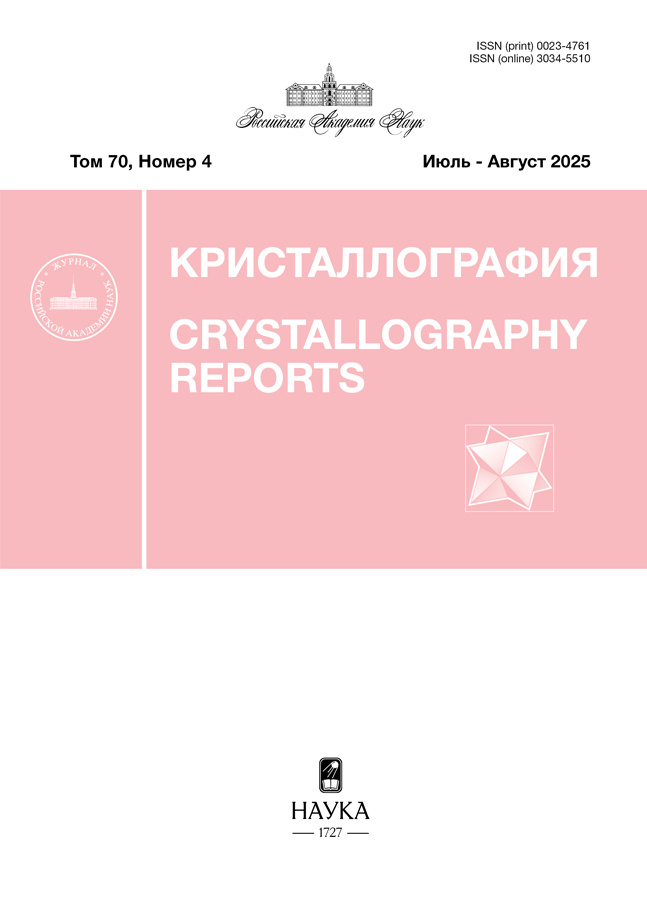Quasi-synchronous second harmonic generation in photonic crystal structures based on iodic acid
- Authors: Konovko A.A.1, Andreev A.V.1, Berezkin V.V.2, Grigoriev Y.V.2, Kriman N.М.1, Reshetova M.V.2, Minaev N.V.2, Epifanov E.O.2, Asadchikov V.E.2
-
Affiliations:
- Lomonosov Moscow State University
- National Research Center “Kurchatov Institute”
- Issue: Vol 70, No 4 (2025)
- Pages: 698–704
- Section: МЕТАМАТЕРИАЛЫ И ФОТОННЫЕ КРИСТАЛЛЫ
- URL: https://clinpractice.ru/0023-4761/article/view/688096
- DOI: https://doi.org/10.31857/S0023476125040206
- EDN: https://elibrary.ru/JIFHBD
- ID: 688096
Cite item
Abstract
The frequency conversion efficiency of the long-wavelength part of the optical spectrum is considered. The problem of generating the second harmonic in two-dimensional photonic crystals based on iodic acid is considered in order to convert long-wave radiation into the visible range for subsequent registration by traditional silicon detectors. The problems of synthesis of two-dimensional photonic crystal structures for practical problems of nonlinear optics and photonics are discussed.
Full Text
About the authors
A. A. Konovko
Lomonosov Moscow State University
Author for correspondence.
Email: konovkoaa@my.msu.ru
Russian Federation, Moscow
A. V. Andreev
Lomonosov Moscow State University
Email: konovkoaa@my.msu.ru
Russian Federation, Moscow
V. V. Berezkin
National Research Center “Kurchatov Institute”
Email: konovkoaa@my.msu.ru
Shubnikov Institute of Crystallography of the Kurchatov Complex Crystallography and Photonics
Russian Federation, MoscowYu. V. Grigoriev
National Research Center “Kurchatov Institute”
Email: konovkoaa@my.msu.ru
Shubnikov Institute of Crystallography of the Kurchatov Complex Crystallography and Photonics
Russian Federation, MoscowN. М. R. Kriman
Lomonosov Moscow State University
Email: konovkoaa@my.msu.ru
Russian Federation, Moscow
M. V. Reshetova
National Research Center “Kurchatov Institute”
Email: konovkoaa@my.msu.ru
Shubnikov Institute of Crystallography of the Kurchatov Complex Crystallography and Photonics
Russian Federation, MoscowN. V. Minaev
National Research Center “Kurchatov Institute”
Email: konovkoaa@my.msu.ru
Shubnikov Institute of Crystallography of the Kurchatov Complex Crystallography and Photonics
Russian Federation, MoscowE. O. Epifanov
National Research Center “Kurchatov Institute”
Email: konovkoaa@my.msu.ru
Shubnikov Institute of Crystallography of the Kurchatov Complex Crystallography and Photonics
Russian Federation, MoscowV. E. Asadchikov
National Research Center “Kurchatov Institute”
Email: asad@crys.ras.ru
Shubnikov Institute of Crystallography of the Kurchatov Complex Crystallography and Photonics
Russian Federation, MoscowReferences
- Pircher M., Götzinger E., Leitgeb R. et al. // Opt. Express. 2003. V. 11. № 18. P. 2190. https://doi.org/10.1364/oe.11.002190
- Terrazas-Nájera C.A., Romero A., Felice R., Wicker R. // Additive Manufacturing. 2023. V. 63. P. 103404. https://doi.org/10.1016/j.addma.2023.103404
- Wang W., Paliwal J. // Sens. Instrum. Food Quality. 2007. V. 1. P. 193. https://doi.org/10.1007/s11694-007-9022-0
- Chrzanowski K. // Opto-Electron. Rev. 2023. V. 31. № 1. P. e145327. https://doi.org/10.24425/10.24425/opelre.2023.145327
- Høgstedt L., Fix A., Wirth M. et al. // Opt. Express. 2016. V. 24. № 5. P. 5152. https://doi.org/10.1364/OE.24.00515
- Rogalski A., Kopytko M., Martyniuk P. // Appl. Phys. Rev. 2019. V. 6. P. 021316.
- Midwinter J.E. // Appl. Phys. Lett. 1969. V. 14. P. 29. https://doi.org/10.1063/1.1652645
- Del Rocio Camacho-Morales M., Rocco D., Xu L. et al. // Adv. Photon. 2021. V. 3. № 3. P. 036002. https://doi.org/10.1117/1.AP.3.3.036002
- Chen J.-Y., Tang C., Ma Z.-H. et al. // Opt. Lett. 2020. V. 45. № 13. P. 3389. https://doi.org/10.1364/OL.393445
- Асадчиков В.Е., Бедин С.А., Васильев А.Б. и др. // Поверхность. Рентген., синхротр. и нейтрон. исслед. 2022. № 3. С. 10. https://doi.org/10.31857/S1028096022030037
- Асадчиков В.Е., Бедин С.А., Березкин В.В. и др. // Письма в ЖТФ. 2022. Т. 48. Вып. 6. С. 7. https://doi.org/10.21883/PJTF.2022.06.52203.19084
- Armstrong J.A., Bloembergen N., Ducuing J., Pershan P.S. // Phys. Rev. 1962. V. 127. № 6. P. 1918. https://doi.org/10.1103/PhysRev.127.1918
- Fejer M.M., Magel G.A., Jundt D.H. et al. // IEEE J. Quantum Electron. 1992. V. 28. № 11. P. 2631. https://doi.org/10.1109/3.161322
- Волков В.В., Лаптев Г.Д., Морозов Е.Ю. и др. // Квантовая электроника. 1998. Т. 25. № 11. С. 1046. https://doi.org/10.1070/QE1998v028n11ABEH001377
- Кравцов Н.В., Лаптев Г.Д., Наумова И.И. и др. // Квантовая электроника. 2002. Т. 32. № 10. С. 923. https://doi.org/10.1070/QE2002v032n10ABEH002318
- Sakoda K., Ohtaka K. // Phys. Rev. B. 1996. V. 54. № 8. P. 5742. https://doi.org/10.1103/PhysRevB.54.5742
- Scalora M., Bloemer M.J., Manka A.S. et al. // Phys. Rev. A. 1997. V. 56. № 4. P. 3166. https://doi.org/10.1103/PhysRevA.56.3166
- Balakin A.V., Bushuev V.A., Mantsyzov B.I. et al. // Phys. Rev. E. 2001. V. 63. P. 046609. https://doi.org/10.1103/PhysRevE.63.046609
- Li J.J., Li Z.Y., Zhang D.Z. // Phys. Rev. E. 2007. V. 75. P. 056606. https://doi.org/10.1103/PhysRevE.75.056606
- Plihal M., Maradudin A.A. // Phys. Rev. B. 1991. V. 44. P. 8565. https://doi.org/10.1103/PhysRevB.44.8565
- Minaev N.V., Tarkhov M.A., Dudova D.S. et al. // Laser Phys. Lett. 2018. V. 15. № 2. P. 026002. https://doi.org/10.1088/1612-202X/aa8bd1
- Shavkuta B.S., Gerasimov M.Y., Minaev N.V. et al. // Laser Phys. Lett. 2018. V. 15. P. 015602. https://doi.org/10.1088/1612-202X/aa963b
- Epifanov E.O., Tarkhov M.A., Timofeeva E.R. et al. // Laser Phys. Lett. 2021. V. 18 (3). P. 036201. https://doi.org/10.1088/1612-202X/abdcc1
Supplementary files















